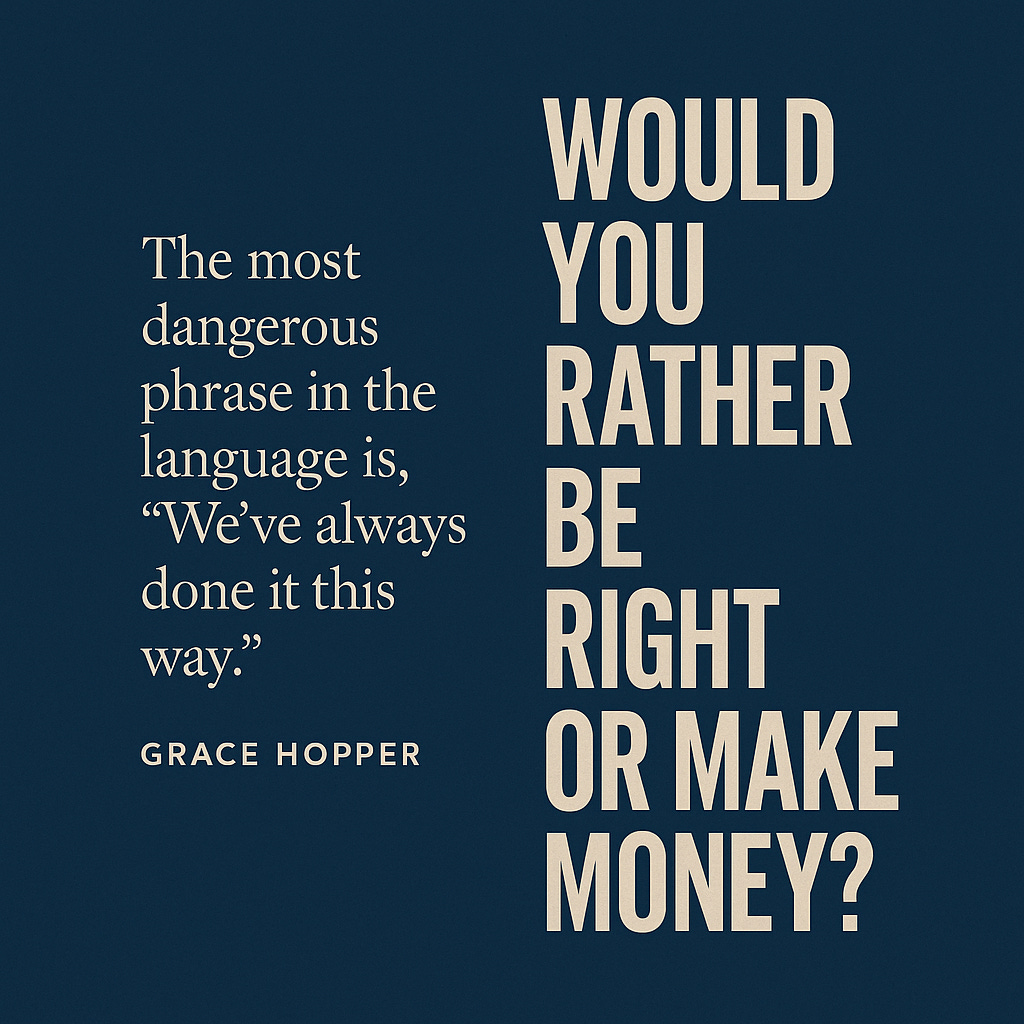Which Is Better In Investing: Being Right, or Making Money?
And The Top 10 Reasons To Take A 10-Day Vacation
I don’t know about where you live, but here in the ATL, with Maycember behind us, it’s (un)officially summer. And because we’re dedicated to exploring and helping you with a more expansive view of wealth on the Net Worthwhile® Weekly—encompassing your Time, Influence, Money, Energy, and Relationships—we regularly offer insight into that which may not seem as quantitative as traditional financial planning. It’s Financial LIFE Planning.
So, this week, I’m giving you a quick summary of a post I wrote years ago that ended up going semi-viral on Lifehacker. But that’s not all.
On our video podcast, Tony and I are asking and answering the pivotal investment question: Which is better—being right or making money? And Tony explicates that concept further in his Weekly Market Update as well, along with a great chart and read on a host of investment indicators.
Thanks for joining us!
Tim
Tim Maurer, CFP®, RLP®
Chief Advisory Officer
In this Net Worthwhile® Weekly you'll find:
Financial LIFE Planning:
The Top 10 Reasons To Take A 10-Day Vacation
Bonus Podcast:
Which Is Better: Being Right Or Making Money?
Quote O' The Week:
Grace Hopper
Weekly Market Update:
The Compounding Of Investing Biases
Financial LIFE Planning
Top 10 Reasons To Take A 10-Day Vacation:
1. Most importantly, a 10-day vacation gives you the time necessary to surrender, to capitulate, to truly vacate. Even when we love our work—in fact, maybe especially when we love our work—it’s so immersive that it takes us a couple/few days just to get out of our ingrained work routines and into our vacation vibe.
2. Travel consumes a lesser percentage of your total vacation time. If you’re going someplace worth going, you’re likely sacrificing a day getting there and another getting back. Whether by plane, train or automobile—and even if the actual travel time is only half-a-day—the stress and logistical maneuvering consume a full two days. That’s almost 30% of the seven-day vacation, but only 20% of a 10-day break.
3. Because travel consumes proportionately less of the 10-day vaca, it also opens the door to a traveling vacation with multiple stops. A second stop or change in geographic context can give your single vacation the feel of two separate trips, each with their own set of lasting memories.
4. You’re gone long enough that you’re forced to off-load your duties at work. If I take a three or four-day weekend, I rarely even set my email out-of-office notification or update my voicemail message. I’m effectively taking a vacation while still on the clock in my mind. When I take a seven-day vacation, I’m hesitant to completely check-out of my work responsibilities and even feel guilty asking for help. But if I’m going to be missing days in more than two different work weeks, I really have no choice but to arrange for enough back-up help at the office to truly separate myself from the duties I’m hesitant to relinquish.
5. You’re gone long enough that you’re forced to budget financially for the vacation. I don’t recommend taking a trip of any length without having budgeted for it. It takes away from the refreshment we seek when we have to wonder how we’re going to pay for the vacation when we get home. The additional time and cost of a 10-day vacation really demand budgeting in advance of your departure. Additionally, I recommend seeing where you stand financially five days in so you can recalibrate if necessary for the second half of your trip.
6. A 10-day vacation leaves sufficient time for the creation of memories through experience and the catharsis of do-nothing relaxation. One of the books I enjoyed over one memorable vacation was Laura Vanderkam’s, What the Most Successful People Do on the Weekend. I found much of the wisdom therein applied just as well to vacations as to weekends. Vanderkam suggests that we “set anchors”—activities to which we apply some forethought, with the aim of memory creation—and allow relaxation to fill the gaps in between. None of us wants vacation to feel like work, filled with have-to-dos, but these anchors are, in contrast, want-do-dos.
7. You have the time to actually develop rhythms of life unique to that particular vacation. One of my favorite things to do on vacations is to find new rituals that seem to apply to that particular area and our family’s phase of life. Personally, I try to maintain some semblance of a workout regimen so I don’t feel quite so guilty about over-exposing myself to the local cuisine, but I need to create a new routine that also isn’t unnecessarily interrupting the family flow. Whether for you or yours, it takes a few days to explore and find the rhythms that will work in a particular place and time.
8. You get the joy of seeing the week and weekend vacationers leave—while you’re kicked back “working” on reading your second novel by the pool. There is nothing fun about leaving an enjoyable vacation, but when your vacation begins or spills over into the middle of a week, you get to watch other people yell at their kids for slow-playing the departure process while you order a fruity umbrella drink. Those days on which everyone else is travelling and checking in or out are also great days for planning an anchor event (see #6) when you’ll likely have less competition.
9. You can avoid the dreaded vacation hangover. Long weekends can feel torturously short and seven-day vacations often leave you wishing you could go back in time, but by the time a 10-day vacation is over, you’re starting to warm to the idea of getting life and work back to normal. The idea of sleeping in your own bed has increasing appeal, eating out has started to weigh you down, spending money like Congress has begun to feel self-indulgent and you’re almost anxious to get back to the daily rhythms of work and rest on the home front.
10. You come home a better spouse, parent, employee—a better person. A 10-day vacation has the highest probability (I submit!) of providing the rest, relaxation and lifelong memories that we all hope to get, but rarely do, from the highlight of our summers. Conversely, taking fewer days often leaves a residue of dissatisfaction that leaves us perpetually wanting more. So go ahead, tack a few extra days onto your next vacation. We’ll all be better for it.
This post was originally published for Forbes.com.
Bonus Podcast
Do You Want To Be Right--Or Make Money?
💡 Episode Summary: In this thought-provoking 7-minute episode, Tim Maurer and Tony Welch explore a deceptively simple but critical question in investing: Is it more important to be right or to make money?
Quote O' The Week
This week’s quote comes from a pioneering computer scientist and U.S. Navy rear admiral who helped develop the first computer compiler and was instrumental in the creation of COBOL, one of the earliest programming languages.
Grace Hopper
“The most dangerous phrase in the language is, ‘We’ve always done it this way.’”
Weekly Market Update
Despite observing the world’s two most powerful people (arguably) break into open warfare, the market whistled a happy tune into the weekend:
+ 1.50% .SPX (500 U.S. large companies)
+ 1.13% IWD (U.S. large value companies)
+ 3.33% IWM (U.S. small companies)
+ 2.49% IWN (U.S. small value companies)
+ 0.79% EFV (International value companies)
+ 0.96% SCZ (International small companies)
- 0.98% VGIT (U.S. intermediate-term Treasury bonds
The Compounding Of Investing Biases
Contributed by Tony Welch, CFA®, CFP®, CMT, Chief Investment Officer, SignatureFD
One of my favorite questions, which my long-time mentor, Ned Davis, used to ask, was, “Would you rather be right, or would you rather make money?” He even wrote a book with the title above. Most people reading this would instantly say, “Making money, is this a real question?” But, that doesn’t necessarily match human psychology. We tend to have an intense drive to be right, sometimes at the expense of making money. Three well-documented behavioral biases are:
Confirmation bias – the tendency to favor information that supports existing beliefs.
Overconfidence bias – an inflated sense of one’s own knowledge, predictive powers, or correctness.
Belief Perseverance – the tendency to maintain a belief even after the evidence supporting it has been discredited.
And while you may be thinking, if I’m right, I’m surely going to make money, we need to remember that markets don’t make it that easy on us. In fact, it's possible to “be right” most of the time and still lose money. The chart below is an example. In red, it plots an indicator that shows whether the market is short-term oversold or overbought, with a rule in which you “buy” when the market is oversold and “sell” when the market is overbought.
We can see from the statistics in the top left corner that this system has been right 70% of the time. For those that have ever tried to actively trade, they can attest that 70% is a very high winning percentage. However, note that this system has lost an investor nearly 3% on an annualized basis and 88% overall. It is, therefore, quite possible to be right but lose money.
That’s why we want to remain objective and flexible. Additionally, we aim to avoid market timing. It is often detrimental to hitting your long-term Grow goals. While being right can be very satisfying, the name of the game for an investor is making money, which, as you can see, is not necessarily the same thing.
Chart of the Week
The Message from Our Indicators
Last week gave us another batch of mixed economic data. Purchasing Managers’ Indexes (PMI) from S&P and ISM diverged from each other, with the former indicating moderate strength and the latter suggesting economic weakness. Factory orders and auto sales were down, and the ADP employment report showed only 37,000 new jobs added in May. But on the positive side, job openings in April picked up and the official BLS Employment Situation report was adequate for May. The economy added 139,000 jobs, the unemployment rate held steady at 4.2% and hourly wages picked up 3.9% over the past year. Employment is something of a lagging indicator, but it would appear the economy was in solid shape in May.
The futures markets are not pricing in a high probability of a Fed rate cut until September, despite other central banks like the ECB moving ahead with more rate cuts. The economic data has been solid enough to support an extended pause while waiting for more data. In the PMI surveys, there was a notable increase in the price components, showing that tariffs are having an impact. We believe the Fed is likely waiting to see how much of those higher prices are being passed on to consumers. Thus far, the inflation data has remained benign.
We expect investor attention is likely to shift at least somewhat from trade policy to the tax bill and corporate earnings. We believe the tax bill is unlikely to add much more stimulus, but extending the tax cuts would prevent a major fiscal headwind from hitting at a time when tariffs may pose something of a consumption tax hike.
Regarding earnings, the one-year forward earnings estimate for U.S. stocks is about 11%. It has been our view that valuations are somewhat expensive, and therefore, market gains are likely to be limited to the growth in earnings, potentially somewhat less. The good news for investors is that market technicals have become a tailwind, given the strong rally from the April low. Historically, strong price thrusts, as we have recently seen, have been followed by better-than-average 12-month returns.
All told, our indicators describe an economy that is imperfect but growing, which should support positive earnings growth in upcoming quarters. We would expect returns to be in line with the degree of earnings improvement, owing to relatively rich valuations.
Wherever this weekend—or your summer vaca—takes you, I hope it involves some rest and reflection!
Tim






